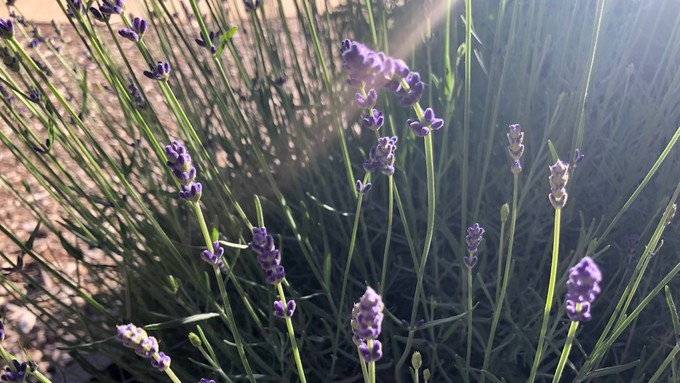
Free workshop covers how to grow, harvest and use this popular herb

Lavender prefers a bright, dry spot with relatively poor soil -- and good drainage. Kathy Morrison
Have California gardeners adopted a Mediterranean mindset? Using Google searches as a measure, a study by horticultural guide Gardening Chores concluded that lavender is California’s favorite flower.
Not only is it California’s top searched-for flower, but No. 1 in 41 states plus the District of Columbia, says the report.
Second among searched-for flowers (coupled with the phrase “how to grow”) in California was sunflower, followed by rose, peony and hydrangea.
Why lavender? It’s more than just a pretty flower, explained horticulture expert Amber Noyes, Gardening Chores executive editor, who is based in San Mateo.
“Lavender provides many benefits to the area in which it is grown and can thrive both outdoors and indoors with proper care,” she said in the report’s announcement. “From its widely acknowledged pleasant fragrance to its beautiful violet flowers, it provides a welcoming space for pollinators, and acts as an excellent repellent of nuisance garden insects, such as mosquitoes and ticks.
“With this in mind, it stands to reason that lavender would be the most popular flower in California. It will be particularly interesting to see whether the most-searched-for flowers are also the most frequently grown by those cultivating their gardens this summer.”
A lot of those “how to grow” searches may have come due to struggling lavender plants. Lavender likes a challenge. It’s usually killed by kindness. Instead of rich soil and lots of irrigation, it wants a bright, dry spot with relatively poor soil. It demands good drainage.
Native to the Mediterranean region and drought-tolerant, the lavender genus includes 47 species and more than 450 varieties. Lavender is a favorite with bees and a must for pollinator gardens.
Besides attracting beneficial insects, the flowers have culinary and medicinal uses. Their fragrance promotes relaxation.
Learn more in a free workshop at 9 a.m. Wednesday, June 14, at the Cameron Park Community Center. Presented by the El Dorado County master gardeners, “All About Lavender” is just that – an information-packed three-hour session about how to grow, harvest and use this versatile herb.
Master gardeners Donna Marshall and Muriel Stephenson will teach the lavender basics and a lot more. The class includes how to propagate lavender, and everyone will leave with their own cuttings to root.
No advance registration is necessary. Cameron Park Community Center is located at 2502 Country Club Drive, Cameron Park.
Questions? Email mgeldorado@ucanr.edu.
Details: https://mgeldorado.ucanr.edu/
Comments
0 comments have been posted.Sacramento Digs Gardening to your inbox.
Sites We Like
Garden Checklist for week of Nov. 3
November still offers good weather for fall planting:
* If you haven't already, it's time to clean up the remains of summer. Pull faded annuals and vegetables. Prune dead or broken branches from trees.
* Now is the best time to plant most trees and shrubs. This gives them plenty of time for root development before spring growth. They also benefit from fall and winter rains.
* Set out cool-weather annuals such as pansies and snapdragons.
* Lettuce, cabbage and broccoli also can be planted now.
* Plant garlic and onions.
* Keep planting bulbs to spread out your spring bloom. Some possible suggestions: daffodils, crocuses, hyacinths, tulips, anemones and scillas.
* This is also a good time to seed wildflowers and plant such spring bloomers as sweet pea, sweet alyssum and bachelor buttons.
* Rake and compost leaves, but dispose of any diseased plant material. For example, if peach and nectarine trees showed signs of leaf curl this year, clean up under trees and dispose of those leaves instead of composting.
* Save dry stalks and seedpods from poppies and coneflowers for fall bouquets and holiday decorating.
* For holiday blooms indoors, plant paperwhite narcissus bulbs now. Fill a shallow bowl or dish with 2 inches of rocks or pebbles. Place bulbs in the dish with the root end nestled in the rocks. Add water until it just touches the bottom of the bulbs. Place the dish in a sunny window. Add water as needed.
* Give your azaleas, gardenias and camellias a boost with chelated iron.
* For larger blooms, pinch off some camellia buds.
* Prune non-flowering trees and shrubs while dormant.
* To help prevent leaf curl, apply a copper fungicide spray to peach and nectarine trees after they lose their leaves this month. Leaf curl, which shows up in the spring, is caused by a fungus that winters as spores on the limbs and around the tree in fallen leaves. Sprays are most effective now.